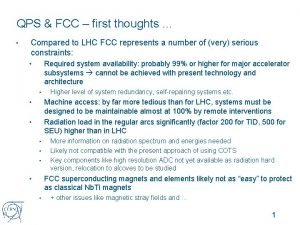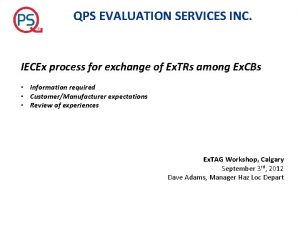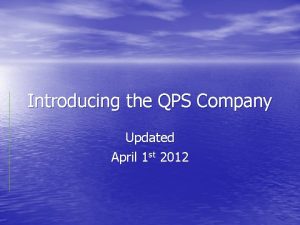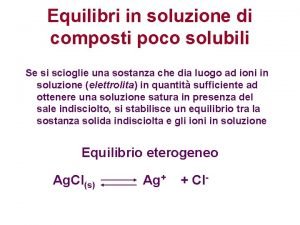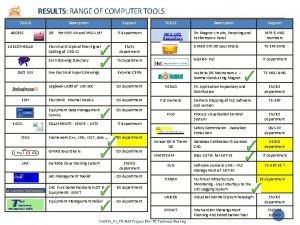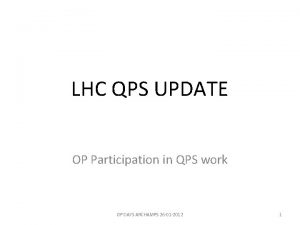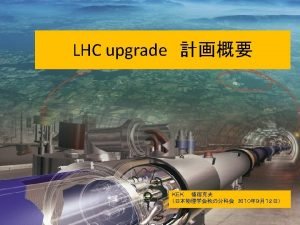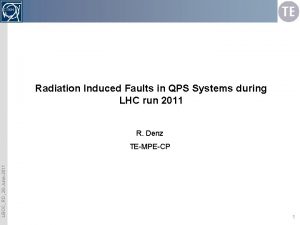QPS FCC first thoughts Compared to LHC FCC






- Slides: 6

QPS & FCC – first thoughts … • Compared to LHC FCC represents a number of (very) serious constraints: Required system availability: probably 99% or higher for major accelerator subsystems cannot be achieved with present technology and architecture • • Higher level of system redundancy, self-repairing systems etc. Machine access: by far more tedious than for LHC, systems must be designed to be maintainable almost at 100% by remote interventions Radiation load in the regular arcs significantly (factor 200 for TID, 500 for SEU) higher than in LHC • • • More information on radiation spectrum and energies needed Likely not compatible with the present approach of using COTS Key components like high resolution ADC not yet available as radiation hard version, relocation to alcoves to be studied FCC superconducting magnets and elements likely not as “easy” to protect as classical Nb. Ti magnets • • + other issues like magnetic stray fields and … 1

QPS & FCC – first thoughts continued … • Main circuits will still require protection and detection systems for each individual magnet Quench Detection Systems (QDS) + DAQ Active protection elements like quench heater discharge power supplies (DQHDS) and/or CLIQ • • Advanced global detection & protection schemes could be used for the protection of insertion region magnets, triplets, correctors etc. • • Necessary radiation tolerance for the power device may become a real challenge Would allow to install electronics in protected areas in close to the interaction points (as in LHC) FCC operational mode will have an impact on design of QPS electronics • • How many long shutdowns, interval between shutdowns Preemptive maintenance to cope with radiation loads by replacing a substantial part of electronics during long shutdowns 2

QPS & FCC – possible strategies: baseline • Classic: install QPS in protected areas (= alcoves) and connect to protected magnet by instrumentation and power cables Concerns main circuits only QDS/DAQ: maximum cable length to be defined; 100 -200 m should be no problem if correctly done • • So far verified maximum cable length corresponds to maximum distance between alcoves of ~500 m additional tests for longer distance to be performed The impact of the magnet stray fields especially their variation in time on the magnet instrumentation needs as well to be better understood DQHDS/CLIQ: maximum cable length depends only on available cross section example assuming 1. 5 km between alcoves: • • DQHDS: 2 x 10 mm 2 750 m ≡ 2. 7 Ω ΔU (I = 100 A) = 270 V CLIQ: 2 x 100 mm 2 750 m ≡ 0. 27 Ω ΔU (I = 2 k. A) = 540 V could be compensated by increased charging voltages 3

QDS/DAQ & FCC – possible strategies: alternative not relying on protected areas in FCC tunnel • Install QDS main processing units in protected areas (could be surface) and transmit magnet information by distributed intelligent I/O (= ADC + transmitter) Transmission either through Ethernet (wired or optical or even wireless) Main processing unit could manage protection of complete sector Available options for radiation hardening still to be studied • • • Local shielding might be an option but feasibility will depend strongly on expected radiation distribution and energy Devices could be very small in size and may be located differently than in LHC DQHDS/CLIQ: install locally underneath protected magnet • • Possible space constraints in case of CLIQ Power semiconductors currently used for triggering DQHDS/CLIQ discharges could become a showstopper 4

QDS/DAQ & FCC – possible development of a radiation hardened deported I/O Component Status Remark Radiation hardened communication link available e. g. GBT project (optical) Could be used as well for optical interlock … High resolution fast ADC up to ~ 1 k. Gy feasible with latest generation fast high resolution SAR ADC (still COTS!) Fully rad-hard development feasible if sufficient lead time (yes!). Competence available at CERN (EP department) or with specialized institutes (Toulouse …) Input stage amplifiers etc. Up to ~ 500 Gy feasible with COTS, SEE immunity to be verified Currently the limiting factor, which would apply as well to other solutions like 4 -20 m. A current loops Auxiliary power supplies To be verified but used by LHC experiments Available Conclusion: feasible considering sufficient lead time for R&D; could be tested in LHC 5

QPS active protection elements exposed to radiation i. e. CLIQ and DQHDS (if quench heaters still a la mode …) Component Status Remark Controls part and interlocks Feasible as for detection electronics See previous slides Auxiliary power supplies Available See previous slides Passive components for Promising results during energy storage previous developments 1 k. Gy or more should be feasible R&D and testing required, preemptive maintenance can be very costly … Power devices (IGBT, thyristor, BCT etc. …) The not so easy part … also due to the fact that these devices are not used by other R 2 E communities. Some experience with thyristors up to ~500 Gy, EPC might have tested IGBTs Conclusion: feasibility for power devices still to be proven; may require a substantial R&D program. 6
